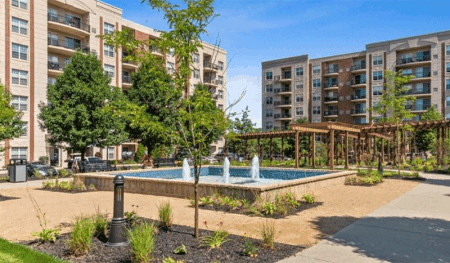
ReNew Downers Grove in Downers Grove, Illinois, a property of FPA Multifamily, a privately held real estate investment company that specializes in apartment acquisition, development, and asset management. FPA’s staff is conducting a portfolio-wide fact-finding assessment to both inform energy- and water-saving retrofits and collect data for green building certifications.
While some large buildings are largely empty in the near term, multifamily real estate is facing the opposite challenge: unprecedented continuous occupancy. Residents are working from home and staying at home—cooking more meals at home, using other appliances more or less all day, in addition to elevated use of heating and cooling systems. The properties may be seeing more elevator trips, more in-and-out foot traffic with food and package deliveries, more outside air ventilation, and the need for more intensive and frequent cleaning of common areas.
All of this translates to increased energy use at multifamily properties, with owners measuring peak usage at far higher levels than the energy loads they are used to managing.
What are owners doing about this sudden spike in multifamily energy use? In other sectors, owners can ask tenants to reduce energy and can tighten base building systems to save on costs. But the multifamily sector is where residents call home, where they look for comfort, safety, and a sense of place. As such, owners are trying to strike a sensitive balance when considering options to optimize and address this increased load, while also working with their residents to navigate the new physical risk challenges posed by COVID-19.
Multifamily energy use can be broken down into two segments, each addressed differently during this tumultuous time.
- Base building systems and common areas: The central plant and base building systems are part of the building the owner controls—though with owners keen on providing comfort and wellness to residents, energy conservation measures like setpoint changes that could result in discomfort are not a priority, and daytime construction project noise from major maintenance and capital projects would also be an inconvenience to the residents staying home all day. With fitness centers, pools, and party rooms closed to residents, multifamily operators can reduce some energy usage levels by unplugging devices and exercise equipment, turning off lights and screens, draining pools, and reducing temperature setpoints in those rooms—though this does not represent a significant impact on the overall load in most buildings.
- Resident units: Residents with triple-net lease structures are directly responsible for their energy bills. Without owner control, it is up to the residents to monitor and manage their usage. In these times, owners are finding it more appropriate to communicate more sensitive topics on health and wellness than fiscal topics like energy savings. As owners gain access to whole-building aggregated usage (often available from utilities in regions with mandatory benchmarking ordinances), that may drive increased owner-funded improvements such as the installation of smart thermostats.
Instead of taking immediate action (and risking delivery of tone-deaf messages to residents), multifamily owners are using this time to plan internally for future energy efficiency project implementation. The facilities team of FPA Multifamily, a privately held real estate investment company that specializes in apartment acquisition, development, and asset management, had extra capacity since they can only complete emergency work orders, and redirected staff to conduct a portfolio-wide fact-finding assessment initiative to both inform energy- and water-saving retrofits and collect data for green building certifications.
“Our vice presidents of facilities management and our regional facilities managers mobilized their teams quickly. In less than two weeks, we were able to collect data on hundreds of different data-points for about 160 properties,” says Kylie Flanagan, environmental, social, and governance (ESG) director, FPA Multifamily. “Our Green Team has been empowered with incredible data to inform future retrofit projects, which before the pandemic we weren’t actively discussing.”
Some properties, like those owned by Equity Residential, a publicly traded real estate investment trust that invests in apartments, are well positioned to minimize the energy burden on their residents, since they have already invested in energy-efficient improvements.
“Historically, we’ve installed energy-efficient appliances, lighting and water fixtures, as well as programmable thermostats in tens of thousands of units over the years, which should position in-unit energy/water use to already have a lower baseline,” says Katherine Elliot, director, investments and sustainability, Equity Residential.
Many anticipate that the work-from-home culture brought on by shelter in place—and thus, increased energy loads in multifamily buildings—will at a minimum linger for some time if not become the new normal. Firms like Bozzuto, a property manager with luxury apartments throughout the Mid-Atlantic, Chicago, Atlanta, and Charlotte, are planning ahead to strategize how increased energy loads play into operational decisions.
“This is a critical focus for properties with loans tied to Energy Star scores derived from whole-building energy consumption, as well as our communities located in the growing number of cities that are mandating incredibly high energy performance standards. While all multifamily properties are likely going through similar patterns right now, our long-term discussions are certainly factoring in how we adapt now to new energy consumption patterns that will most certainly be impacted by whatever our new normal looks like,” says Pete Zadoretzky, vice president, sustainability, Bozzuto Management Company.
All things considered, multifamily owners are prioritizing their residents’ interests and strategizing for future efficiency improvements, which is exactly what the market needs.





